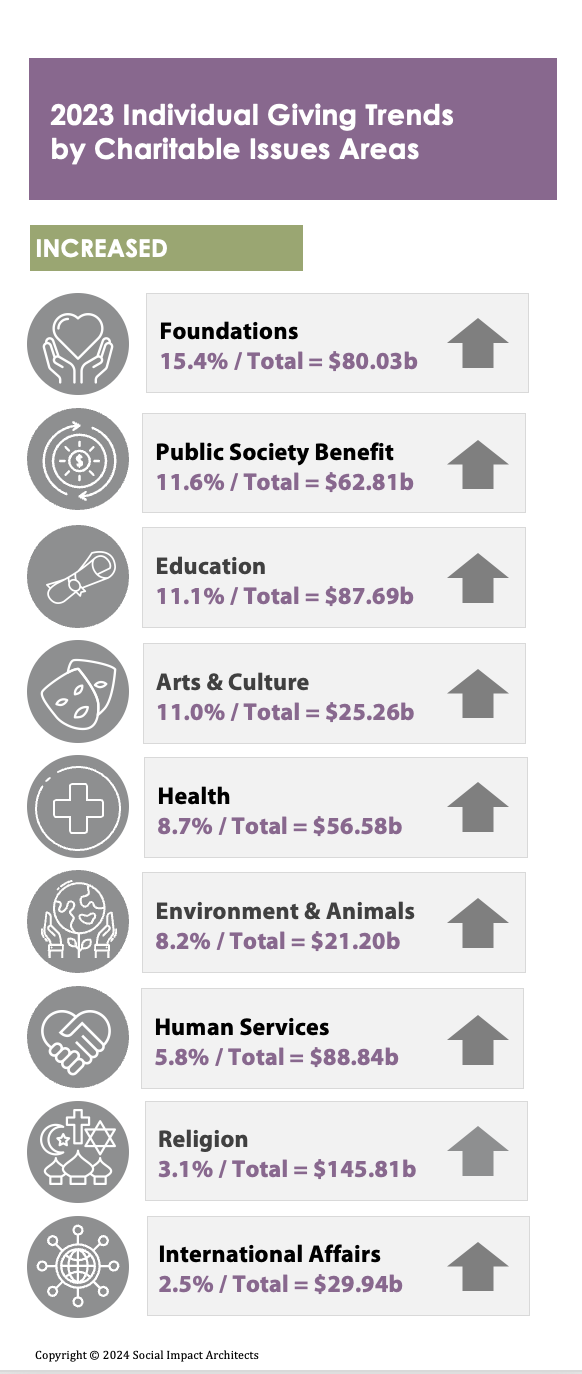 This year, in the World Giving Index, the United States emerged as the most charitable country – with 72% of Americans reporting that they helped a stranger, 61% donated to a charity and 42% volunteered their time. But, as economic and societal shifts occur, that ranking may change. With the recent Giving USA 2024 report – the social sector’s annual report – we once again partnered with our friends at Wise Resource Development to drill down on today’s giving trends and help your fundraising team make sense of them for future planning.
This year, in the World Giving Index, the United States emerged as the most charitable country – with 72% of Americans reporting that they helped a stranger, 61% donated to a charity and 42% volunteered their time. But, as economic and societal shifts occur, that ranking may change. With the recent Giving USA 2024 report – the social sector’s annual report – we once again partnered with our friends at Wise Resource Development to drill down on today’s giving trends and help your fundraising team make sense of them for future planning.
Charitable giving reached a record-breaking $557.16 billion (in current dollars) in 2023. This was great news to many of us who saw the double-digit decline the previous year and were concerned that a downward trend might continue. In fact, giving increased 1.9% in current dollars (but was down 2.1% when adjusted for inflation).
As for the sources of generosity in 2023, individuals still are the backbone of American charity (with 67% of all giving) – which increased 1.6% (not adjusted for inflation). After individuals, foundations also continued their strong support of charities, accounting for 19% of charitable giving (an increase of 1.7%). In fact, giving by foundations crossed the $100B mark last year and continues to grow. Corporations also increased giving by 3%, and we expect their influence to grow. Bequests continued to increase (with a 4.8% increase), which shows that the generational wealth transfer is happening as expected.
Since we started an annual tradition of reporting on the Giving USA Report in 2019, we have discussed the trends year-by-year and shared ideas for your agency’s fundraising plan. This year, we wanted to take a longer-term look, focusing on key trends that are here to stay.
Trend #1: Giving Trends Over 20 Years Reflect Stability of Philanthropy and a Shift in Priorities
Generosity is stable and resilient, as giving by all types of donors has continued to increase steadily over the past 20 years. The sharpest increase in giving over the past five years came from corporations and foundations. According to Giving USA, corporations and foundations have become more innovative and relational in their giving practices during and since the COVID-19 pandemic. While individual giving continues to be the largest source of giving, it is down from 80% of giving in 1984. Foundations have filled this gap, increasing their giving from 7% to 17% over the past 20 years. Donor-advised funds have also become an increasingly popular tool for giving. Corporate giving and bequests remained steady over the past 20 years in terms of percentage of giving. Giving over the past 20 years has also stayed relatively steady in terms of percentage of gross domestic product and share of disposable personal income at about 2% for each. The most successful and sustainable nonprofits have a diverse portfolio of all four giving sources – individuals, foundations, corporations and bequests – ensuring that their overall fundraising will be secure as the market and priorities fluctuate.
Giving USA 2024 also provides interesting insights into shifting giving interests. While religious organizations have remained the largest recipients of giving over the past 20 years, the percentage of giving to religion has decreased by more than half, from 57% of giving between 1984 and 1988 to 27% of giving between 2019 and 2023. The largest increases in giving over the past 20 years have been to human services (10% increase), foundations (7%) and international affairs (6%). Interestingly, according to the report: “5 of 9 subsectors reached their all-time high in 2023, even when adjusted for inflation: human services; education; health; arts, culture and humanities; and environment/animals.”
Trend #2: The Great Transfer of Wealth Is Here
Everyone has been hearing about the Great Wealth Transfer, but now it is happening. Money magazine estimates more than $84 trillion will be passed from one generation to the next through 2045, with roughly 14% of that potentially going to charitable giving. If you do not have a planned giving strategy, it’s time to implement one. If you are not inviting your longtime donors to support your nonprofit via planned giving, you are not only missing out on helping your regular donors leave a legacy, but also on potentially transformative funding for your mission. There are simple ways to implement a planned giving program for all levels of organizational capacity and budget sizes. Just adding a statement about legacy giving on your marketing materials and website can help your donors to self-identify. And we recommend doing research on all your donors to identify likely planned giving prospects.
Trend #3: Younger Donors Are Now Your Greatest Donors
It is also time to re-evaluate the way you engage younger donors. Generation-Xers, Millennials and Gen Zers have already demonstrated a great deal of philanthropic generosity. They are also coming into a whole lot of family wealth. Members of the Silent and Baby Boomer generations are already involving younger generations in philanthropic decision-making, and their giving interests are not the same as their parents and grandparents, causing shifts in giving. Additionally, research shows that younger generations want to be cultivated and communicated with in a different way – expecting a high level of relationship and engagement. We recommend reading Millennial Philanthropy by Holly Hull Miori, Ph.D., to learn more about how to understand the giving trends of Millennials.
Trend #4: Corporate Giving Has Had the Largest Total Increase Over the Past Two Years
Organizations without a corporate giving strategy should consider incorporating corporate outreach efforts into their development plan. Corporate giving includes cash and in-kind contributions made through corporate giving programs, as well as grants and gifts made by corporate foundations. Corporations have become more creative and relational in how they invest in nonprofits, including foundation philanthropic funds, marketing dollars for sponsorship opportunities, employee giving and volunteering through Employee Resource Groups, fundraising support (vendor campaigns), board or committee leadership, and pro-bono skills. An easy way to implement a corporate giving strategy right away is to reach out to board members, volunteers and donors to see if they will introduce you to the person responsible for community giving where they work. When you meet with the company representative, ask them exploratory questions about ways that they engage with nonprofits and what their ideal mission-driven partnership would look like. Companies often want to test out a relationship with a nonprofit by volunteering or doing a small project together first, so make sure that you steward all corporate relationships no matter the level and cultivate volunteer groups to become more involved in other ways. Strong corporate relationships can take years to develop. And because companies are more likely to experience turnover with decision makers, a key to longevity is to build relationships with multiple leaders at different levels across the company.
Trend #5: Fundraising Totals Are NOT Impacted by Political Cycle, but Messaging Is Impacted
We have heard some nonprofits being concerned that funds directed toward the presidential election might cause a decrease in charitable donations. This is a common misperception. Political contributions are more akin to disaster relief – Americans add political donations to their giving while they continue donating to their favorite causes.
However, fundraising is impacted by political messaging. We predict that political messaging will be at an all-time high in late October and early November, so nonprofits may want to shift Giving Day and annual appeals schedules accordingly. Because donors may be overwhelmed by political campaign messages, you may want to pause emails and social media – except for evergreen messages – during this timeframe and come back strong after the election in mid-November.
2024 has come with both opportunities and challenges – this summer is a great time to review these trends against your experience and adjust your fundraising plan based on new information and insights. We welcome any additional analysis based on your donor relationships as well as any ways your organization is shifting its fundraising efforts to better respond to their needs.

